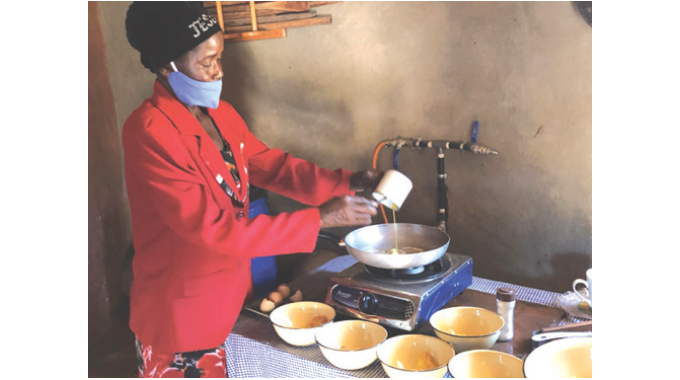
Lungelo Ndhlovu
RURAL communities in Bandama and Dungwe villages in Chiredzi and Mwenezi respectively have resorted to biogas technology for their cooking energy needs and as such no longer cut down trees for firewood.
Most rural communities, have since time immemorial, solely relied on firewood for heating and the cutting down of trees had now become a worrying problem.
The biogas technology, which involves the process of producing energy by fermenting cow dung and waste is gaining popularity in most rural households across Zimbabwe thereby saving trees.
When the Zimbabwe Resilience Building Fund (ZRBF) Enhancing Community Resilience and Sustainability (Ecras) project, a long-term development initiative, introduced biogas technology to rural Chiredzi, communities stopped cutting down trees as the biogas provided a “cleaner source of energy”.
One household which is among those now using biogas technology in Ward 4 Bandama Village in rural Chiredzi district, told the Chronicle, that burning biogas has totally improved their lives.
“A lot of heat is generated from the biogas stove and cooking doesn’t take more than 30 minutes. Even cooking time for sugar beans or trotters is reduced. My children and I no longer go out to cut down trees in the veld because we are relying on the gas,” said Mrs Dzingai Dumela.
She said their concern was to ensure they have material to burn to produce the biogas.
“Our only worry is to keep the biogas burning in the kitchen but this is not an issue for me because cow dung is readily available in my kraal. Every morning we just go and collect cow dung which we use to feed into the biogas digester,” Mrs Dumela said.
Mr Cosmos Gombo, Agritex officer for Chiredzi District said the district is in natural Region 5 which is prone to droughts.
The primary livelihoods for locals are drought resistant crops such as sorghum, pearl millet, sunflower and groundnuts, he said.
“At times the district receives erratic rains and the situation has been worsened by climate change issues. The ZBRF Ecras project came in to assist villagers with water harvesting methods to enable them to capture as much as possible of the rain water and this biogas technology, which reduces the cutting down of trees. I am pleased that a number of families have put these technologies into their daily practice,” he said.
Mr Gift Machukela, the District Development Co-ordinator for Chiredzi said his office has noted a significant change in rural livelihoods as a result of ZRBF and Ecras projects.
“Our communities have adopted these projects and the results are amazing. Solar-powered boreholes have been established and the use of biogas technologies has made it easier for women to prepare meals without going out to fetch firewood,” he said.
The biogas technology is also a hit in Mwenezi District and Mrs Sister Hlongwani, a villager from Dungwe Village in Ward 1, praised the method saying it was highly efficient.
“In setting up this biogas digester, we hired local boys to dig the pit and we mostly use resources at our disposal that we feed into the digester. We used 1 890 kilogrammes of waste and same amount of water when we started using it,” she said.
In implementing these biogas technologies in rural communities, the ZRBF and the Ecras project partnered with the Ministry of Lands, Agriculture, Fisheries, Water and Rural Resettlement.
Almost US$10 million funding was allocated into the ZRBF and Ecras project by the European Union, the Embassy of Sweden and the United Nations Development Programme. The project which started in July 2016 is running until June 2022.
Mr Bekithemba Ngwenya the Forestry Commission District Conservator for Bulawayo said cutting down of trees is a big challenge, both for urban and rural communities across Zimbabwe.
“A lot of people are now relying on firewood for energy and it has a serious impact on our forests and land degradation. Forest degradation increases especially during the winter time. We are not saying people should not use firewood but they are supposed to follow procedures,” he said in an interview.
Mr Ngwenya highlighted that it is a requirement for communities who wish to transport firewood to acquire firewood movement permits, which are obtainable from the Forestry Commission.
“By so doing it allows us to regulate the way people cut down trees. Suppose you have a farm and you want to cut firewood, the requirement is you must first get clearance from the Forestry Commission. After the Forestry Commission has inspected your farm, we also monitor the cutting down of those trees. But unfortunately most of our people don’t come through our office and this is a cause for concern because we are losing a lot of trees,” he said.
Forestry Commission figures show that Zimbabwe loses about 330 000 hectares of forests annually while forest and woodland now cover 45 percent of its land area, down from 53 percent in 2014.
“We also encourage the planting of gumtrees, which are tolerant to drought. Gumtrees can grow in most of our areas, are fast growing and people can use the wood as firewood. In this part of the country, gumtrees do not perform as well as in other provinces such as Mashonaland.
Most people in Mashonaland are now into tobacco production so it is now a requirement that for one to grow tobacco, they are supposed to have a one hectare plantation of gumtrees. These are the gumtrees they are supposed to use for tobacco curing because without the gumtree plantation, they won’t have firewood,” said Mr Ngwenya.
